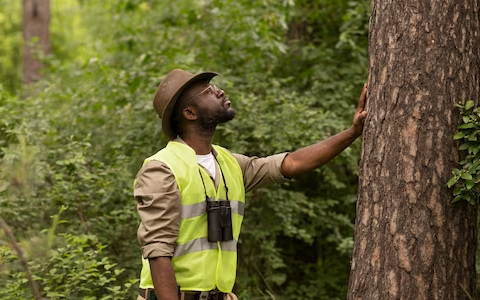Bachelor Of Science (Honours) Degree In Forest Resources And Wildlife Management
- 00h 00m 00s
- 0000-00-00 00:00:00
About Course
Offered In Conventional
SKILL LEVEL COURSE DURATION
Undergraduate (ZNQF Level 8) 4 years
LESSONS:
PURPOSE OF THE PROGRAMME
The programme has been designed to provide education for undergraduate students in forest and wildlife resources management. The education covers issues related to resource use, protection and enhancement of environmental quality. We expect that our students have a love of nature, are fascinated by plants and animals, are interested in conservation, and are concerned about our environment in Zimbabwe and Africa, and the whole world. It is further hoped that the graduates from this programme will develop their abilities to think and analyse issues pertaining to their fields without being limited by the conventional constraints of academic boundaries. Specifically, the programme is expected to:
- Produce competent leaders in the forestry and wildlife sub-sectors who can apply knowledge for conservation development,
- Produce all-round forest and wildlife managers who can appreciate forest and wildlife conservation and tackle conservation challenges,
- Produce forest and wildlife advocacy experts, knowledgeable on the forest and wildlife laws and policies.
- Produce forest and wildlife researchers and law enforcers who are ready to create awareness about the plight of forest and wildlife resources.
ENTRY QUALIFICATIONS
Normal Entry
At least 2 “A” level passes in Geography, Biology and or Chemistry and 5 “O” level subjects at Grade C or better including Mathematics and English Language.
Special Entry
Special entry applicants must have successfully completed National Certificate, National Diploma or Higher National Diploma in Forestry, Wildlife, Natural Resources or its recognized equivalent may apply for entry into Year I.
PROGRAMME CHARACTERISTICS
Structure
The Programme shall consist of thirty-eight (38) modules including industrial attachment and a research project. Year III consists of Industrial Attachment where a student is attached to an organization in the field of study to gain practical experience, and will culminate in the submission of an Industrial Attachment report.
Teaching and Learning Methods
Lectures, tutorials, laboratory classes, field-based practicals, seminars, group work, industrial visits, industrial attachment, research project, and individual independent study.
Assessment Methods
Written and oral examinations, tests, laboratory reports, seminar presentations, industrial attachment report, final year research project report, continuous assessments. Coursework shall constitute 40% (Test 15%, Assignment 5%, Practical 20%) and Written Examinations 60%.
REGULATIONS
The Regulations for the Bachelor of Science Honours degree, hereinafter referred to as the BSc (Hons) Forest Resources and Wildlife Management complement and are subordinate to University General Regulations for undergraduate degrees and Faculty of Environmental Science regulations.
YEAR I
EFW 1101 HUMANS AND THE ENVIRONMENT (10 CREDITS)
Physical geography-physics and chemistry of the earth’s crust, mantle and core; geomorphological processes; climate- weather elements and their measurement, factors affecting climate, global warming, climate change; Atmospheric systems; circulation models. Human population dynamics, major factors influencing population change (birth rate; migration; fertility rate; etc). Method of controlling human population growth; case studies for efforts in controlling population: India, China, Zimbabwe. Natural resources, agriculture and food production land degradation and soil loss; human settlements; energy; industry, environment and resources management; arid and semi-arid land development and management.
SCH 1116 ORGANIC CHEMISTRY (10 CREDITS)
The course seeks to foster an understanding and appreciation of the importance of organic reactions and the 3-dimentional nature of the organic molecules; Structures and bonding in organic molecules; Nomenclature, conformations and reactions of alkanes, alkenes, dienes and alkynes; Introduction to organic reactions and mechanisms: Polar reactions, Free radical reactions, pericyclic reactions; Stereochemistry: isomers: structural isomers, stereo isomers and conformational isomers and structural isomers: chain/branched chain isomers, positional isomers, functional isomers, tautomers; stereoisomers; Benzene and its derivatives; Cyclohexane and carbohydrates; Amino acids; Function of various Spectroscopes.
SCS1100 COMPUTER APPLICATIONS (10 CREDITS)
The course help students to identify computer components and describe the basic environment for computerized information production. The computer; computer generations, types and use of computers, Hardware functional components; central processing unit, input/output units, storage, evaluating computer hardware, the computer as a pivotal component of IT, Database systems; data definition, advantages and disadvantages, examples of database management systems, Computer communications; wired and wireless networks, computers as decision making tools, Computer software; classification of software, word processors, spread sheets, presentation packages, statistical packages, internet and e-mail services, management information systems, web applications, Computer security; computer etiquette, emerging computer technologies.
SMA 1112 PREPARATORY MATHEMATICS (10 CREDITS)
Algebra: Quadratic equations. Laws of indices and logarithms. Partial fractions. Factor and remainder theorems. Binomial expansion. Complex numbers. Trigonometry: Definition of six trigonometric functions for any angle. Trigonometric identities. Compound angles. Matrices: Operations, Inverses. Determinants. Solution of Linear Systems. Functions: Exponential, Logarithmic, Circular functions and their inverses. Calculus: Idea of limit, continuity and derivative. Techniques of differentiation, maxima and minima. Definite and indefinite integrals. Methods of integration, application to areas and volume.
EFW 1102 DIVERSITY OF LIFE (10 CREDITS)
The module gives an overview of the taxonomic diversity of organisms from kingdom Monera to Kingdom Metazoa; Principles of biosystematics: Taxonomy, Classification systems and biological nomenclature; Field collection of specimens, preservation and Identification of plants and animals; Importance of biodiversity; sustainable utilization, conservation and management of biodiversity.
EFW 1104 GENERAL BIOLOGY (10 CREDITS)
This module introduces the fundamental principles and concepts of biology. The main areas emphasized in this module will be cell structure; composition and function, evolution, taxonomy, classification of organisms, genetics, ecology as well as basic chemical and biochemical process in the various kingdoms of life. The structure, classification and importance of major groups of protozoans, bacteria, viruses and fungi, mammals and angiosperms. Anatomic and physiological relationships between tissues and organs in mammals with reference to systems (alimentary, excretory, vascular etc). Homeostatic mechanisms.
EFW 1201 INTRODUCTION TO FORESTRY (10 CREDITS)
Definition and philosophy: The concepts of a normal forest, sustained yield and multiple use: Products of the forest and forest influences, legal basis of forests and other natural resources, measurement and dendrology; forest fires, forest management plans; Nursery practice, silviculture of exotics and indigenous tree species.
EFW 1202 HUMANS AND WILDLIFE (10 CREDITS)
The evolution of man; Hunter-gatherer strategies; Domestication and pastoralism, Human demography and its impacts on natural resource; Environmental damage and species extinction, Man-wildlife interactions; History of conservation; Living resources conservation for sustainable development; Community based wildlife management and sustainable utilization of wildlife resources.
EFW 1206 PLANT AND ANIMAL DISEASES (10 CREDITS)
The importance of good animal and plant health. Signs of good and ill health and causes. Nutritional disorders in wildlife and forest trees. Immunity and the body’s defence mechanism. Causes of diseases; transmission and diagnostic methods; disease prevention and control; emphasis on major diseases of wildlife and forest trees. Biology of vectors and parasites of wildlife and trees; common pests of wildlife and forest trees. Hygiene and prophylaxis in production units and other habitats. Care and treatment of wildlife and forest trees of ill health. Toxicology, bacteriology and virology. Major weeds, weed identification and control measures. Economics of wildlife and forest tree ill health
EFW 1204 PRINCIPLES OF ECOLOGY (10 CREDITS)
Topics covered include types of ecosystems and the interaction of organisms with the physical environment. The course will emphasize on the components of population ecology in terms of population characteristics, population growth, population regulation and the ecological significance of genetic variability. Life history strategies for growth, reproduction and dispersal in plants and animals will be covered. Aspects of community ecology including biotic community characteristics, ecological succession, biomes and theories pertaining to climax concept will also be covered. The course includes a comprehensive understanding of ecosystem organization, ecological pyramids, productivity, ecological efficiencies, food chains & food webs, energy flow in ecosystems. Detailed explanations of biotic interactions comprising mutualism, commensalism, competition, predation, as well as parasitism along with competitive exclusion and niche concept will be covered. A glimpse of wildlife conservation and management will be included, covering protected areas management and wildlife enterprise. Field and laboratory practicals will develop ecological investigation and measurement skills as well as techniques for collecting, preserving and identifying specimens.
ILI 1105 COMMUNICATION SKILLS (10 CREDITS)
Information Literacy Skills (ILS): What is an Information Literate student? Navigating the Internet, NUST website and Library portal; Navigating Library Catalogues; Developing a Search Strategy; E-resources & using online search engines; Plagiarism and the penalties; submitting essays via anti-plagiarism software; ILS: Citation and Referencing- Finding your own critical voice versus cutting, pasting and plagiarizing; Using references as support, not substitution; The concept of citation and referencing; Examples of referencing systems; The Harvard Author Date referencing system; Citing books, periodicals and other hardcopy sources; Citing electronic/online sources & other media; Effective quoting and citing; Effective paraphrasing and citing; Compiling reference lists and bibliographies; Electronic referencing tools: shortcuts for citing; Academic Reading- Reading skills: skimming and scanning; Reading strategies: SQR3R and other methods; Summarizing, paraphrasing and synthesising; Critically evaluating a text; Recognising fact versus opinion; impartiality versus bias; Communication Models: Communication (definition); Elements of communication; Barriers to communication; Models of communication; Nonverbal communication: kinesics, proxemics, artifactual, vocalic, tactile & other; Oral Communication II; Appropriate telephone manners (cell and landline); Job interview strategies
EFW 1205 GEOGRAPHICAL INFORMATION SYSTEMS APPLICATIONS (10 CREDITS)
The course introduces the concepts underlying Geographical Information Systems, with an emphasis on analytical capabilities of such systems in both raster and vector domains. Introduction to GIS, history of GIS, components of GIS, functions of GIS, GIS data model, raster, vector; Data Processing Data input Visualisation and manipulation Vectorise and Rasterise Build geodatabase and edit attributes; Map projections and coordinate systems, Earth-Unwrapping sphere to plane; Geographic coordinate system: Cylindrical, Azimuthal, Conic, UTM; It also gives an insight into the spatial analysis tools of GIS such as spatial analysis; overlay, distance analysis, and network analysis, spatial statistics; spatial autocorrelation, point pattern analysis, spatial interpolation and spatial modelling; hydrological modelling, TIN. Introduction to GIS spatial analyst model; surface analysis and interpolation; raster operations: focal, neighborhood, and zonal filtering; spatial statistics: ESDA / spatial autocorrelation; spatial data output and display.
YEAR II
EFW 2106 PLANT MORPHOLOGY AND DEVELOPMENT (10 CREDITS)
Meristems of roots and shoots; shoot growth patterns and control of crown form; primary stem development, cortical and vascular tissues; leaf structure and growth and variation with sun and shade; vegetative versus reproductive phases, conifer and angiosperm reproductive structures; flower, seed and fruit development, flowering in trees, seed availability, seed dormancy; secondary stem development; Bark formation and the structure and properties of wood, wood cell in relation to density, strength and hygroscopic properties, pitting and water transport; Grain, figuring and spiral grain; Reaction wood and other abnormalities such as knots, shakes. Plant water relations: chemical and water potentials, movement of soil water and availability, mechanisms of water uptake in soil-plant-air systems, cell water relation; Phytohormones and their effects on plant growth: auxins, gibberellins, cytokinins, abscissic acid and ethylene; Biosynthesis, translocation, degradation and effects on plant growth; Mineral nutrition of macro—and micro-elements and deficiency of symptoms; Photosynthesis and transpiration: the light reactions and electron transport system, CO2 assimilation pathways – C3, C4 and CAM plants, bio-productivity, photosynthesis/transpiration compromise; stress physiology: drought, salinity and environmental pollution.
EFW 2102 MAMMALOGY (10 CREDITS)
Mammalian orders and characteristics; Anatomy, form and function; classification; Home range; Migration; Communication, play, sexual, parental; Social organization; Interspecific behaviour, predator and anti-predator behavior.
EFW 2104 SOCIAL FORESTRY & EXTENSION (10 CREDITS)
Sociological perspective applied to natural resources management; rural social Institutions and land tenure; tree tenure, traditional uses of trees, religious and cultural significance; Trees on farms; constraints on tree growing by rural people; Role of forestry in rural development; History of forestry and development; interaction of forestry and small farmers, squatters; Economic aspects of social forestry projects and case studies; Definition of forestry extension as a factor of social change, Extension methods; Principles and techniques of effective use of materials, including use of media and preparation of talks and displays; organization and appraisal of extension programmes; Training of field extension workers; Role of Government and NGOs in social forestry and extension.
EFW 2105 WILDLIFE NUTRITION (10 CREDITS)
Nutritive quality of forage and its metabolism; Secondary compounds; analysis of food habitat; Microbial and non-microbial digestion; Function and partition of nutrients; Requirements of important mammals; assessing nutritional status; Physiological indicators of condition; Supplementation.
ESH 2108 ENVIRONMENTAL ECONOMICS (10 CREDITS)
Basic economic principles; scope, nature and methodology of economics; Economics systems: traditional, planned/command, Liaise Faire enterprise/free market, mixed; theory of price determination: definition of a market, supply and demand. Relationship between society and economic development, public and private choices, and their impact on the environment. Theories of development economics. The factors of economic growth: land, labour, capital and entrepreneurship. Gross national Product; economic growth and the environment; Paying for privilege to pollute; measurement of cost benefit analysis (CBA). Comparison of cost benefit analysis and Environmental impact Assessment (EIA) as tools for appraisal. Linkage between economic planning, development, environmental management and legislature. Risks, uncertainties, and impact on resource use.
CBM 2105 TECHNO-ENTREPRENEURSHIP (10 CREDITS)
Introduction to the Origins and Concept of Entrepreneurship: The concept of entrepreneurship and intrapreneurship, History/origins of entrepreneurship, Types of entrepreneurship, Characteristics of successful entrepreneurs; Role of the entrepreneur and the intrapreneur in the economy; Cultural Diversity of Entrepreneurship; Challenges of Entrepreneurs; Factors that Contribute to the Success of Entrepreneurs; Creativity and Innovation; Disruptive, Incremental and Open innovations; Nurturing and Managing Innovation; Intellectual property rights; What is intellectual Property; Patents; Utility Models; Trademarks; Industrial Designs; Copyright; IP and Small and Medium-sized enterprises and large enterprises; Other forms of IP; venture creation and management; Entrepreneurship Environment; Feasibility Analysis; Marketing and Market Research (venture opportunity screening); Forms of Ventures; Legal and Regulatory Framework; Developing the Business Model of the Venture/project; Start-up capital and Financial Statements; costing; pricing, business plan.
EFW 2201 ORNITHOLOGY (10 CREDITS)
Evolution, systematics and taxonomy’ Anatomy, physiology, embryology, reproduction and behaviour; Distribution, abundance and bird ecology; Avian management: ostrich.
EFW 2201 AGROFORESTRY (10 CREDITS)
Introduction to agroforestry: concepts, systems, practices and technologies; Analysis of existing agroforestry systems. Purpose and productivity of these systems; Ecophysiology and agroforestry systems, crop phenology, biomass distribution, competition within and between strata; Light energy and water incidence, interception, utilization and measurement; Integration of livestock in agroforestry systems; participatory planning, diagnosis and design methods; Research; examination and evaluation of projects in high potential and dry land zone; Improvement of agroforestry programmes; Role of government and NGO nurseries; Socio-economics of systems, effects of land use changes on labour and productivity; Role of cash versus food crops; Integration of livestock and fish into systems.
EFW 2203 PLANT SYSTEMATICS AND FIELD IDENTIFICATION (10 CREDITS)
Knowledge of morphological, ecological and phonological traits used in field identification; Woody plant vegetation of southern Africa, uses, habitats, distribution, cultivation. Botanical or scientific common names of tree species from the families, Fabaceae, Oleaceae, Moroceae etc. Identify exotics, shrubs, climbers.
EFW 2204 RESEARCH METHODS AND STATISTICS (10 CREDITS)
Purpose of doing research, Scientific and other methods of conducting research; the research process: formulating research problems, data collection procedures, data procession and analysis; report writing; different kinds of research designs such as survey, participant observation, experimentation and quasi-experimentation; consumption of research results; ethics in research.
EFW 2205 VERTEBRATE POPULATION DYNAMICS (10 CREDITS)
Concepts of population; Birth and deaths rates, life tables; Population characteristics; Population Structure; Dispersal; population growth models and dynamics; Rate of Fluctuations; Population size; density and distribution; survival and mortality, predator-prey interactions; survivorship curves and K-factor analysis, Population analysis in management.
PROJECT MANAGEMENT
YEAR III
EFW 3001 INDUSTRIAL ATTACHMENT (120 CREDITS)
The third year is an internship period in which students undertake an industrial placement for a minimum of eight months. At the place of attachment, students generally have a supervisor who assigns them specific tasks and evaluates their work. The internship is a compulsory part of the degree programme. It is formally assessed. Assessments include the writing of a reflective log and an evaluative report by students and a performance evaluation report by the industrial supervisor. The internship is expected to give students an insight into the world of work and to allow the students to build on the theory they would have learnt at university as well as explore their career options. At times, employers use internships as a trial period for prospective employees, thus students get an opportunity for an offer of a full-time job. After the internship, students would gain practical skills that help strengthen their curriculum vitae, increasing their chances of being employed.
YEAR IV
EFW 4010 RESEARCH PROJECT
The student shall, under supervision and guidance, carry out an independent investigation into a problem of his/her choice. He/she shall collect data, interpret results and write a report to illustrate the understanding of the issues relating to the problem. The report must demonstrate the relationship between theoretical knowledge and its application to field situations.
EFW 4101 FOREST MENSURATION (10 CREDITS)
Introduction to methods of forest mensuration; Methods of measurement; Measurement of timber products and timer; Measurements of growing trees and stands; Mensurational parameters; structures of uneven-aged stands and even-aged monocultures or pure stands; Yield estimation by felling model trees; Bitterlich’s methods of basal area determination; Mensuration of increment: mean annual (MAI) and current annual (CAI) increments; Stem analysis; Determination of increment of growing trees and stands; Growth of stands.
EFW 4102 FOREST & WILDLIFE POLICY & LAW (10 CREDITS)
Goals of wildlife conservation; Conservation areas as a form of land use, Regulations, prohibitions and legislative provisions; Enforcement of national and international laws and regulations; Establishment of parks, reserves and protected areas; Sources of funding for wildlife management programmes; Management and regulations of wildlife utilization; Wildlife depredation and compensation; Ethical standards and professionalism. Wildlife Policy (translocation procedures, culling, red zones, quarantines).
EFW 4103 ANIMAL ECOLOGY (10 CREDITS)
Animal interactions; Intraspecific competition. Predation, coevolution and specialization amongst predators, optimal foraging, functional response of predator to prey availability, aggregated effects, Interference, prey-predator dynamics-models; Plant-herbivore interactions; Mutualism, Parasitism. Other interactions, Determinants of community structure and function. Examples shall be drawn only from Africa e.g., Serengeti Ecosystem. Biogeography and designing of conservation areas.
EFW 4107 WILDLIFE MANAGEMENT (10 CREDITS)
Habitat management; the wildlife range, carrying capacity, habitat requirements of animals; Habitat improvements; vegetation control; Impacts of land use practices (forestry, agriculture, urbanization, tourism)’ Population management: factors limiting vertebrate populations; Effects of predation, predator management and exploitation dynamics; Overpopulation and control methods; People management: human surveys, multiple use, forestry and agriculture, pesticides, urban wildlife resources; Buffer zones and dispersal areas; Translocation and exotic wildlife; Management of endangered species and ecosystems; Causes of threats and extinctions.
* EFW 4108 SILVICULTURE (Elective; 10 CREDITS)
Introduction to Silviculture; Role of Silviculture in forest management, Tree growth patterns; Forest and stand dynamics; Natural disturbance regimes; Physiological and ecological principles of regeneration. Elements of forest protection, Silviculture systems: even-aged natural reproduction methods, uneven–aged natural reproduction methods. Intermediate stand treatments; Factors in silvicultural system selection. Nursery production, introduction to nursery practices; phases in nursery production; bed preparation; sowing; control of shoot and root morphology; mechanical site preparation; planting. Site preparation and planting, introduction to silviculture treatments; the seedling microsite; an overview of its manipulation through site preparation, mechanical site preparation. Planting, monitoring and protection-plantation protection; risk assessment; overview of insect and mammal pests, plant diseases.
EFW 4109 FOREST MANAGEMENT (10 CREDITS)
Definition and scope; Forest organization; The principles of sustained yield and normal forest; Yield regulation, rotation; Felling plans and programmes of work, introduction to the preparation of forest management plans; forest fire behavior and effects; Fire ecology and uses in land management; Firefighting equipment, firefighting organization.
* EFW 4203 FOREST HARVESTING & UTILISATION (Elective; 10 CREDITS)
Timber crops – the goal of forestry. Planning timber harvesting; Principles to reduce impact logging; Factors affecting the productivity, efficiency, and cost of logging; tools used. Transportation of products from the forest; Planning harvesting operations; non-timer products and harvesting; Utilization of forest products Introduction to forest industries and marketing. Forest industry structure in Zimbabwe. International, regional and domestic forest markets. Demand, supply and future demand of forest products. Marketing strategies. Niche markets. Certification as a marketing tool. Development of Forest sectors and marketing in Zimbabwe and southern Africa; Small-scale Forest industry.
RESEARCH PROJECT ((40 CREDITS)
EFW 4201 FOREST SURVEYING & REMOTE SENSING (10 CREDITS)
Theory of measurement and errors; Linear and angular measurements; Triangulation, traversing, mapping by plane tabling and chain surveys; Profile and differential leveling, contours and contouring; Preparation of plans and maps; Area and volume computations; Basic principles of photogrammetry, the aerial camera, vertical photographs; Characteristics of photographic images, stereo viewing and the construction of aerial mosaics; Interpretation of remotely sensed images for selected forestry application.
EFW 4202 BIODIVERSITY & CONSERVATION (10 CREDITS)
Biodiversity: origin of the term, themes embraced, history of life on earth, current biodiversity crisis. The creation of biodiversity: ecological patterns and processes, evolution and the diversity of species, Inventory of planet earth: defining types of biodiversity, quantifying biodiversity, global patterns of biodiversity, and the role of ecosystems. Components of biodiversity; Extinction; valuing biodiversity. The conservation of biodiversity: new attitudes to conservation. Biodiversity and productivity and stability of ecosystems; biodiversity and ecological redundancy. Local community and biodiversity conservation. Techniques – assessment, evaluation, monitoring.
EFW 4204 SOIL CHEMISTRY & FERTILITY (10 CREDITS)
Inorganic components of soil structures and properties of layer silicates and other accessory materials; Soil organic matter and its role in plant nutrition; Cation exchange and diffuse double layer, anion and molecular retention; Acid and salt affected soil; irrigation; water quality and method of reclamation; Soil as plant nutrient medium; Nutrition and plant growth; Macro and micro-nutrients, nutrient cycling; Nutrient diagnostic technique, with emphasis on trees; Mineral fertilizers, manures, and general aspects of fertility management; Environmental impacts of fertilizers and other agrochemicals.
ESH2108 ENVIRONMENTAL IMPACT ASSESSMENT (10 CREDITS)
Concepts and issues in environmental management: objectives of EIAs/EHIAs; terminologies etc. Statutory provisions of EIA in Zimbabwe; brief on the Environmental and Natural Resources Act, etc. Introduction to the EIA process: screening; scoping; impact identification (forms of impacts, data sources; sources of impacts etc.); impact assessment (techniques and analysis tools); migratory measures; the EIA report; draft EIA reviews (assessing the quality of draft Environmental Impact statement etc.); project implementation; decommissioning. Case Studies such as EIA of water resources, energy development, mining, paper industry etc.
* EFW 4208 ENTOMOLOGY FOR FOREST & WILDLIFE (Elective; 10 CREDITS)
General introduction to entomology: Place of insects in animal kingdom; Taxonomy of major insect groups and the characteristic features of those important to forestry; Biology, ecology and their control (cultural, chemical and biological control of major forest insect pests in southern Africa); fruit/seed pests, root pests, defoliators, bard and stem/wood borers; Useful forest insects; biology of important insect orders, ticks and mites in wildlife management; insect social system and behavior; The coevolution of predator-prey population dynamics; Insect diversity and community stability; growth and life tables; Economic importance of insects, ticks and mites; The biology of ticks, mites, tsetse flies, sand flies and mosquitoes and their importance in disease transmission; Commercial value of insects and their product; Insect preservation.
* EFW 4110 WETLAND ECOLOGY (Elective; 10 CREDITS)
Definitions and types of wetlands; Biotic components; Distribution of water in Southern Africa; Water quality – nutrients, pollution, pesticides; Nutrient cycling; Wetland processes and functions; Watershed – volumes, flows, evaporation, degradation; Wetland resources and productivity, and harvesting; Fish and waterbird diversity and stocks; Alien weeds and control; Management and conservation of wetlands using African examples; Ramsar Convention.
EFW 4104 RANGELAND ECOLOGY & MANAGEMENT (10 CREDITS)
Introduction: definitions, rangeland characteristics, distribution, importance, limitations; Grazing areas of the world; Range plants-identification, nutritive values, poisonous plants; Development/History of Range Management; Ecology of rangelands in relation to grazing; Range inventory, condition, monitoring and evaluation; animal nutrition; Management of proper use; Planning grazing use of the range; Range vegetation management for forage production; Dynamics of rangeland ecosystems – equilibrium vs. non-equilibrium views; Ecology of fire; Concept of carrying capacity estimation; Data collection techniques.





